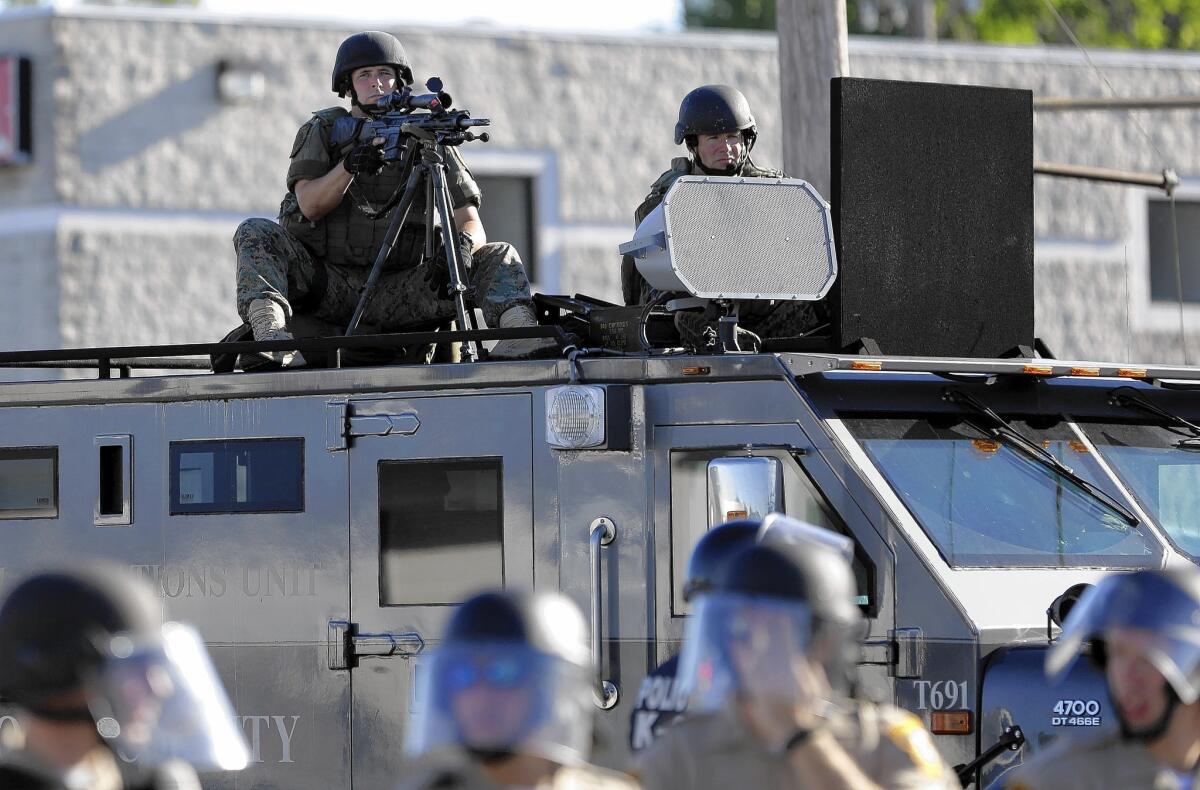Lawmakers question practice of giving military equipment to police

- Share via
Reporting from Washington — Responding to public outcry over images of heavily armed police officers in Ferguson, Mo., last month, lawmakers called Tuesday for closer examination of federal programs that distribute military equipment to state and local law enforcement agencies.
“Most Americans were uncomfortable with a suburban street in St. Louis being transformed into a war zone,” said Sen. Claire McCaskill (D-Mo.). “Those lawful, peaceful protesters did not deserve to be treated like enemy combatants.”
Since 1997, the Pentagon has provided more than $5 billion worth of military equipment to local police agencies as a way to get rid of surplus weaponry and gear. The local agencies can get armored vehicles, assault rifles, night-vision goggles and other equipment, all for free. The departments of Homeland Security and Justice also have programs that provide grants to local police to obtain military equipment.
The programs came under scrutiny after nights of unrest last month in Ferguson, in which local police forces often traveled in armored personnel vehicles, carried assault rifles and used tear gas and rubber bullets to quell crowds who were protesting the shooting death of a black 18-year-old by a white police officer.
Sen. Rand Paul (R-Ky.), long a critic of the growth of militarized police forces, called them “crazy out of control.” Noting that some city police were given bayonets, he said, “I can’t imagine any use for a bayonet in an urban setting.”
Under questioning from lawmakers, the federal agencies that provide the arms defended the programs, citing the usefulness of the equipment in supporting local law enforcement and for first responders in natural disasters.
After last year’s Boston Marathon bombings, police there used military equipment they had received through grants, said Brian Kamoie, a Federal Emergency Management Agency official.
Agency representatives also emphasized that state officials are responsible for determining whether the equipment is necessary and how it is used.
“The Department of Defense does not push equipment on any police force,” said Defense Undersecretary Alan Estevez. “Local law enforcement decides what it needs.”
Of more immediate concern to the lawmakers was the distribution of large armored trucks used to withstand military ambushes and explosives. Thirteen police departments with fewer than 10 full-time officers have received the vehicles, according to the Senate Homeland Security Committee. In many states, police departments have more of them than the National Guard does.
McCaskill gave no sign that lawmakers intended to cut the programs but said after the hearing that improved community policing programs and more training about how to use the equipment might better serve the towns and cities where it is sent.
She also said she expected to see a list of ideas about how to increase federal accountability and oversight of police departments that get the equipment.
“The people that are running these programs couldn’t tell me when and how this equipment is being utilized,” she said. “That’s a huge problem.”
The senator also noted that some of the surplus equipment is new when it is given away and questioned the Department of Defense’s budgeting. Since 2011, the Pentagon has transferred nearly 400,000 pieces of surplus military equipment nationwide.
“It doesn’t appear that buying new equipment to give it away, and then spending money to give it away, is an effective use” of resources, she said during the hearing.
Though associated more recently with the growth of national security programs since the Sept. 11 terrorist attacks, the giveaways are a legacy of the war on drugs, Peter Kraska, a professor at the School of Justice Studies at Eastern Kentucky University, said in written testimony.
They can be traced in part to a Reagan-era legal amendment allowing for weapons to flow between the federal government and local police forces to fight drug dealers and gangs, he said.
“The militarization trend … had everything to do with prosecuting the drug war,” Kraska said. “And that’s when we saw the precipitous rise in not only the number of SWAT units but their amount of activity.”
Years of drug raids by increasingly militarized police, often in black neighborhoods, also exacerbated the racial disparities between local forces and the communities they serve, said one witness, Hilary Shelton of the National Assn. for the Advancement of Colored People.
Though the shooting death of unarmed 18-year-old Michael Brown in Ferguson and the aftermath brought attention to the surplus programs, said Shelton, “it is a sad commentary on race in America that this is not a new phenomena to most Americans of color.”
More to Read
Sign up for Essential California
The most important California stories and recommendations in your inbox every morning.
You may occasionally receive promotional content from the Los Angeles Times.













